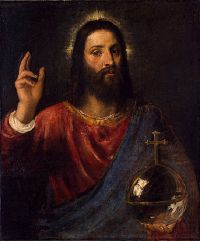Difference between revisions of "Iconography" - New World Encyclopedia
m |
|||
| Line 35: | Line 35: | ||
{{credit|24832770}} | {{credit|24832770}} | ||
| − | [[category:Philosophy and | + | [[category:Philosophy and religion]] |
Revision as of 21:02, 6 October 2005
Iconography is the study and interpretation of images in art. This includes both religious and secular images of all varieties.
Images have been used by many different religions including Hinduism, Buddhism, and Christianity.
Images of Hindu gods use a rich symbolism. Some figures are blue-skinned (the color of heaven) or may have multiple arms holding various symbols depicting aspects of the god (the drums of change, the flower of new life, the fire of destruction, etc.). The many heads, eyes, feet and arms do not have to be taken literally.
Among the best known of Hindu images is that of Shiva dancing in a ring of fire. In one hand he holds a drum with which he brings things into being; in another hand he holds a fire with which things are destroyed. This is a symbol of the Universe, in which there is constant simultaneous creation and destruction.
Another is the God Vishnu dreaming in the Sea of Eternity. As the mythologist Joseph Campbell wrote, "Vishnu, the God, sleeps, and the activity of his mind stuff creates dreams, and we are all his dream: the world is Vishnu's dream."
There is no recognizably Christian art before the 3rd century. At that time the first Christian images, largely motifs borrowed from "pagan" Greco-Roman art of the time and given Christian significance, begin to appear. Eventually Christian art began to lose its symbolic nature, and certain excesses and disputes about the nature and substance of images within Christianity began to arise. Eventually questions concerning the prohibition in the scriptures of graven images split the church into two groups, the Iconoclasts ("breakers" of icons) and the Iconodules (venerators of icons). After much debate at the 7th ecumenical council, held in Nicaea in 787 C.E., the iconodules, supported by the Empress, upheld the use of icons as an integral part of Christian tradition. It was said that the praise and veneration shown to the icon passes over to the archetype. Thus to kiss an icon of Christ was to show love towards Christ Jesus himself, not the wood and paint making up the physical substance of the icon. It was also declared that the prohibition in the Old Testament scriptures against the material depiction of the immaterial God was negated when God took on material flesh in the form of Jesus Christ. There is still substantial disagreement among various Christian denominations over the use of images. Protestants and Catholics venerate them, though they do not use them to the same extent; Protestants use images only for educational and inspiration purposes, believing the commandment against making and venerating images is still in force.

In Eastern Orthodox icons where a portraiture is intended, the emphasis on the spiritual aspects of the person are more important than the actual physical appearance of the person. Traditionally the Eastern Orthodox Christians believe the first icons of Christ and the Virgin Mary to have been painted by St Luke, but none of the many icons attributed to Luke is that old. While at one time Eastern Orthodox Monks often carried out the responsibility of painting icon, in later centuries lay painters, often in workshops, produced by far the majority. The interiors of Orthodox Churches are often completely covered in icons. icons are kissed, carried in procession, and venerated.
See also
- Images of Jesus
- Christian art
- Holy card
External links
de:Ikonografie fr:Iconographie nl:Iconografie pt:Iconografia sv:Ikonografi
Credits
New World Encyclopedia writers and editors rewrote and completed the Wikipedia article in accordance with New World Encyclopedia standards. This article abides by terms of the Creative Commons CC-by-sa 3.0 License (CC-by-sa), which may be used and disseminated with proper attribution. Credit is due under the terms of this license that can reference both the New World Encyclopedia contributors and the selfless volunteer contributors of the Wikimedia Foundation. To cite this article click here for a list of acceptable citing formats.The history of earlier contributions by wikipedians is accessible to researchers here:
The history of this article since it was imported to New World Encyclopedia:
Note: Some restrictions may apply to use of individual images which are separately licensed.